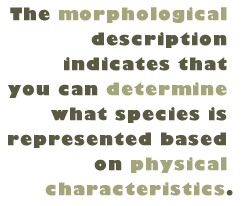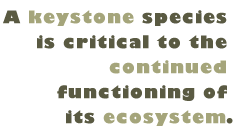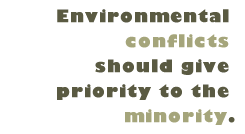Home-Art
329-GS 330-Lit 342-Hum 375-Com
385-GS 410-GS 450, Research-GS
450, Integration
|
|
|
Written by Jessica Albon |
|
|
|
The biological species concept seems to
be the best choice for several reasons. The first reason is that the public has access
to this information; I know that one of our cats cannot produce offspring with one of
our dogs. The second reason this definition seems the most reasonable is that it is
relatively straightforward. While DNA can be questioned—what percentage of overlap is
necessary for two creatures to belong to the same species? —whether two creatures
will breed, given geographic proximity, is a matter of simple observance (as Stephen
Jay Gould explains in Van DeVeer, 495). Thus, the most practical determinant of whether
or not two animals belong to the same species is if they can breed and produce
offspring in nature. |
|
|
Next, I forward that each of these
ecosystems has a keystone species. This keystone species is “responsible for the
smooth functioning of the whole ecosystem” (Effects of Biodiversity web enrichment).
Destroying this keystone species has effects far more damaging than destroying another
species in the same ecosystem. Because this keystone species is critical to the
continued functioning of the ecosystem, its destruction may disrupt the ecosystem, and
thereby disrupt the world environment. These keystone species are of utmost importance
to their ecosystems and thus of the utmost importance to the world environment as well. We cannot know which species in any given
ecosystem is the keystone species. The Effects of Biodiversity web enrichment discusses
that we have no way of knowing if half of the existing rainforests will be able to
survive on their own or if they will perish because of the potential change in
ecological balance. Though we have advanced in many areas, including the environmental,
we still lack knowledge about the consequences of many of our actions. In fact, so many
species are yet unknown to us that we may not even know of the keystone species’
existence in any given ecosystem. We should strive to avoid the alteration
of the world’s environment as we do not know what the results of such an alteration
would be (Van DeVeer, 486-493). This statement means that we must also avoid destroying
or changing any individual ecosystem because individual ecosystems often have an impact
on the world’s environment. Because of the keystone species’ role in an ecosystem,
we must ultimately protect each ecosystem’s keystone species. This poses a problem.
How do we protect a keystone species when we are uncertain which species is the
keystone? In order to protect all potential
keystone species, each species must be treated as though it is the keystone species for
its ecosystem. This assumption will guard us against inadvertently destroying the
keystone species of an ecosystem. While we cannot protect every species from every
other species, we should act in ways that protect these species from humans. Thus,
humans had a duty to remove the wild goats from San Clemente Island because they had
established the goats there in the first place (Van DeVeer, 504 and Ethical Theory in
Rolston web enrichment). These goats posed a threat to three endangered plant species
on the island and removing the goats was the only way to protect the plant
species. Because humans had brought the goats and subsequently put three plant
species at risk, it was a human duty to save the plants, not the goats. If each species
is to be treated as a keystone species then it is the species that is important, not
its individual members. Thus, while protecting the Malacothamnus clementinus,
Castilleja grisea, and Delphinium kinkiense may have necessitated the removal or death
of thousands of goats, humans had a duty to restore the ecosystem’s balance (Van
DeVeer, 504). |
|
|
By considering each species a keystone
species, each species is afforded the same weight as any other. Thus, humans are equal
to chimpanzees, which are equal to horses. While in many political situations it is the
majority who is given the most weight, in environmental considerations they should have
the least while the smallest minorities are seen as the most important. Because of the
small number of the three endangered plant species on San Clemente Island and the large
number of goats worldwide, the San Clemente plants took precedence. Therefore, all species, including endangered species, must be treated as keystone species and should be protected by humans so long as that protection does not jeopardize a greater number of species with extinction. If all species are equal, then the “superkilling,” as Holmes Rolston calls extinction, of any species is atrocious and unreasonable (Van DeVeer, 505). We must guard against such superkillings because eventually we will hit an ecosystem’s keystone species and from there, ecosystems may subsequently topple like dominoes. |
|
|
The difficulty in viewing a species as
important for its members instead of for its species is that one cannot always meet the
needs of each of the members of a species. We cannot protect all humans, all gnats, and
all mockingbirds all at the same time. Instead, we must decide which species requires
that more of its members be afforded consideration. Whether we are dealing with limited
resources or simply deciding which species needs the most attention, we must decide how
to allocate these resources on a species by species basis and not on an individual
creature basis. To decide whether this mockingbird or that needed more grain would be
time poorly spent when other species required the allocation of resources as well.
Thus, out of necessity, we must address the world around us on some unit larger than
individuals and in this case, to address the world using the unit of species makes the
most sense. For the same reason, it would be simpler still to address creatures on the
level of their ecosystem. However, this does not seem to break it down far enough as
there are ecosystems of varying size and with varying numbers of members. By looking at
the needs of specific species in relation to other species, we seem to strike a balance
between too broad a consideration and too narrow a focus. In preserving all species, one may be
committing resources to the preservation of animals that do not need to be preserved,
animals that have outlived their usefulness within the ecosystem. Holmes Rolston argues
that species are important for their role within the ecosystem and that animals such as
the Siberian tigers in North American zoos might be better killed “in order to make
space available for the cats needed to reconstruct and maintain a population that is
genetically more likely to survive upon release” (Van DeVeer, 504). By preserving all
species and working to avoid their destruction, we are working also to perpetuate the
frailty of members of various species. If every time the bison winds up trapped in the
river, we race to its rescue, weaker bison will not be eliminated from the genetic pool
and will produce inferior offspring. By preserving all species regardless, we are doing
ecosystems a disservice. We are weakening them to the point wherein they would not be
able to survive without human intervention. Moreover, ecosystems have a delicate
balance and human intervention could certainly serve to upset that balance (Van DeVeer,
504-511). |
|
|
There is the potential that human
intervention will cause as much harm as good. Unfortunately, we really cannot know for
sure what effect any of our efforts will have. We do, however know that humans are
responsible for a great number of “superkillings,” as Rolston points out (Van
DeVeer, 505-06). We are presently damaging the environment. Attempting to reverse this
damage seems far more reasonable than doing nothing. Realistically, though, Gould
mentions that very few species face extinction from non-human related causes and we
must keep this in mind in considering whether a species may no longer have a place in
its ecosystem (Van DeVeer, 493-497). In the future, we may need to consider whether we
are rescuing a species that we should not rescue. At present, however, I do not believe
we have this luxury. Deciding whether a certain species has value within its ecosystem
would be much like trying to determine which species is the keystone species. And,
unfortunately, such a quest can return misinformed results because as humans we cannot
know everything, nor can we make accurate predictions. Therefore, it is simplest to
treat each species as the keystone species and strive for the protection and
rejuvenation of all species in order to promote diversity and stability throughout the
world’s ecosystems.
See Works Consulted |



 ow
that we have determined how we will define a species, we can begin to unravel the
question of endangered species. To that end, I submit that the destruction of any
ecosystem, no matter how slight, may cause environmental shifts around the world. These
individual ecosystems are of primary importance to the health of the earth and thus
deserve consideration. “If the world’s [individual] ecosystems are forced to evolve
and adapt dramatically, there are an infinite number of ways in which they could evolve”
(Effects of Biodiversity web enrichment). While this statement in the enrichment goes
further to explain that this evolution could potentially produce a world unsuitable for
human life, it makes plain that by changing or destroying ecosystems, one could change
the world’s environment as well. As a result, I suggest that the world’s
environment directly relates to individual ecosystems (Van DeVeer, 486-493).
ow
that we have determined how we will define a species, we can begin to unravel the
question of endangered species. To that end, I submit that the destruction of any
ecosystem, no matter how slight, may cause environmental shifts around the world. These
individual ecosystems are of primary importance to the health of the earth and thus
deserve consideration. “If the world’s [individual] ecosystems are forced to evolve
and adapt dramatically, there are an infinite number of ways in which they could evolve”
(Effects of Biodiversity web enrichment). While this statement in the enrichment goes
further to explain that this evolution could potentially produce a world unsuitable for
human life, it makes plain that by changing or destroying ecosystems, one could change
the world’s environment as well. As a result, I suggest that the world’s
environment directly relates to individual ecosystems (Van DeVeer, 486-493).


 illy-Marlene
Russow believes that we should not address species as entire entities (Van DeVeer,
497-503). Instead, she writes, “an individual has value” (Van DeVeer, 502). She
therefore might take exception with my premise that a species has value. She believes
setting one’s sights on preserving a species because the species carries certain
characteristics is misguided because in reality it is the individual with those
characteristics. Thus, instead of believing we should save species, she believes
individual animals must be saved. She argues for this perspective by writing that in
viewing a species based on its individual members it makes more sense why we would feel
the need to protect an endangered species. Because the basis is with the individual
creature (or experience), she writes, encounters are “more delightful just for their
rarity and unexpectedness” (Van DeVeer, 503).
illy-Marlene
Russow believes that we should not address species as entire entities (Van DeVeer,
497-503). Instead, she writes, “an individual has value” (Van DeVeer, 502). She
therefore might take exception with my premise that a species has value. She believes
setting one’s sights on preserving a species because the species carries certain
characteristics is misguided because in reality it is the individual with those
characteristics. Thus, instead of believing we should save species, she believes
individual animals must be saved. She argues for this perspective by writing that in
viewing a species based on its individual members it makes more sense why we would feel
the need to protect an endangered species. Because the basis is with the individual
creature (or experience), she writes, encounters are “more delightful just for their
rarity and unexpectedness” (Van DeVeer, 503).
 hrough
this argument, I believe I have proven that all species, including endangered species,
must be treated as the keystone species in their ecosystem and should be protected by
humans so long as that protection does not jeopardize a greater number of species. If
all species are equal, then the superkilling of any species is atrocious and
unquestionably wrong. We must guard against these superkillings. If our goal is to
prevent the world environment from changing dramatically, we must preserve individual
ecosystems. Such individual ecosystems are reliant on their keystone species for smooth
functioning. In order to insure the protection of the keystone species of each
ecosystem, we must protect all species of each ecosystem. This seems to be the clearest
way to prevent massive global ecological change.
hrough
this argument, I believe I have proven that all species, including endangered species,
must be treated as the keystone species in their ecosystem and should be protected by
humans so long as that protection does not jeopardize a greater number of species. If
all species are equal, then the superkilling of any species is atrocious and
unquestionably wrong. We must guard against these superkillings. If our goal is to
prevent the world environment from changing dramatically, we must preserve individual
ecosystems. Such individual ecosystems are reliant on their keystone species for smooth
functioning. In order to insure the protection of the keystone species of each
ecosystem, we must protect all species of each ecosystem. This seems to be the clearest
way to prevent massive global ecological change.